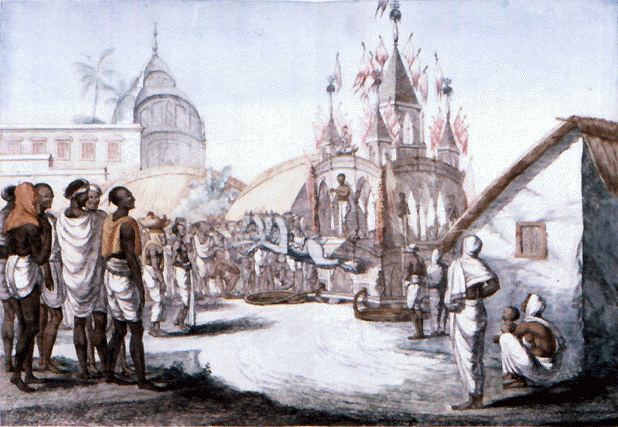Jagannath-Dadhivamana and Kamla
BY: DR. CHITRASEN PASAYAT

Hand-colored Engraving by B. Solvyns, c. 1799
Mar 17, PURI, ORISSA (SUN) — Lord Jagannath worship in association with Dadhivamana manifestation in Bhatli, Puri.
The origin and antiquity of Lord Jagannath is shrouded in mystery. It is difficult for historians to say exactly how and when the Deity has come to be worshipped and has become the most prominent Deity of in the state of Orissa. It is widely believed that Lord Jagannath was a tribal Deity and Hinduised/Sanskritised later on due to tribal/non-tribal interactions. In this paper, an attempt is made to understand the worship of Dadhivamana in the village Bhatli, situated nearly 20 kms. north of Bargarh on the Bargarh- Ambabhona road.
Bhatli is an old village numerically dominated by Brahmin and Kulta population. There is a beautiful Jagannath temple there dedicated to Dadhivamana. Beautiful wall paintings depicting Puranic stories are found inside this temple. There is one story associated with the construction of this temple in Bhatli. It is said that one Paramananda of village Gangpur in Sundargarh district came to Bhatli some one hundred years back. His family consisted of himself, his wife, his son and his daughter-in-law, Kamla. They brought with them their family Deity, Dadhivamana from Gangpur.
It was the duty of Kamla to take care of the deity. Everyday she used to worship Dadhivamana. In course of time, Paramananda became quite popular in the village. He became the Behera, i.e. the village headman of Bhatli. Though honest, Paramananda was poor. He could not decide what to do and how to please the honoured guests of his village. He was very upset and left home chanting the name of Dadhivamana with the hope of collecting food from some generous persons of the village.
It is said that soon after Paramananda left his residence, some proxy of his came to his house and handed over a key to his wife saying that there was some food materials in the room where they used to store paddy. He told her to entertain the guests with that. Thereafter, he left the house saying that he would be coming back soon. Paramananda's wife opened the room and was surprised to see various types of food kept inside the room. On the other hand, Paramananda was disappointed in his hopes. He failed to arrange food for the revered guests. So, after sometime he returned home. "What are you looking so disappointed about?" his wife asked Paramananda and said "the monks are all satisfied with the rich food that was stored in the room meant for storing paddy."
Paramananda eyed his wife with suspicion. Then his wife narrated how he himself handed over the key of the room to her. Paramananda could not hold tears. Weeping like a small child he fell at the feet of his wife saying "you are the most fortunate lady, you could see the Deity Dadhivamana."
A few days after that miraculous incident, the thatched house in which the wooden image of the Deity Dadhivamana was enshrined caught fire. All hopes for saving the image of Lord Dadhivamana were given up. But Kamla was determined to save her revered God. She did not pay any heed to others and without caring for her own life she rushed inside the house wherefrom she never returned. Strangely enough, no remains of Kamla nor of the Deity could be traced out from the ashes. It was believed that Kamla was completely merged into the divinity.
Paramananda, his wife and son were overwhelmed with grief. At night, Paramananda had a strange dream. Lord Dadhivamana appeared before him in the dream and told him that a log of wood will be found next morning floating in the bandh (tank) of the village, which is called Chakra bandh. The image of Lord Dadhivamana should be newly carved out of that wood and be installed in a newly built stone temple in the village.
Next morning, the villagers of Bhatli and neighbouring villages assembled near the Chakra bandh in large number. The sacred log of wood floated towards Paramananda. They were filled with wonder. With tears rolling down his face, Paramananda entered into neck-deep of water and embraced the wood and carried it to his house. Then the images of both Dadhivamana and Kamla were beautifully carved out of that wood. Donations came unasked for as the people vied with one another to offer kar seva (free and voluntary labour) for construction of a big temple. Thereafter, both the images were installed in the temple. It may be noted here that cooked rice or anna bhoga is not offered to Lord Dadhivamana in this temple. The Deity and Kamla enjoy balbhoga only. The car festival of Dadhivamana is observed in the month of Asadha (June-July) with great pomp and ceremony.
On this day Lord Dadhibaman rides on the chariot and sets out on a journey to Mausima Mandir. The Lord stays in Mausima Mandir for nine days, and again on the Dasami of Asadha the return Car Festival is celebrated, as the Lord returns to His temple, to the joy of a huge gathering of devotees at Bhatli.
